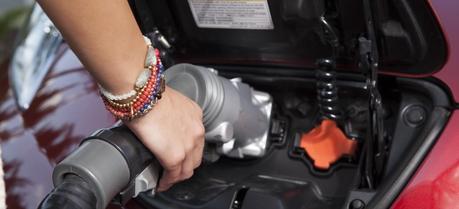 Nissan’s new “vehicle-to-building” system allows up to six Nissan Leafs to be connected to a commercial building’s power distribution board. (Credit: Nissan Motor Company)
Nissan’s new “vehicle-to-building” system allows up to six Nissan Leafs to be connected to a commercial building’s power distribution board. (Credit: Nissan Motor Company)
Nissan has completed a preliminary field test of its new “vehicle-to-building” system that will allow to use a Nissan Leaf battery to store and supply electricity. This way, companies will be able to regulate their electricity bills using the batteries of Nissan Leafs used by their staff to commute to work.
According to a recent report released by the Technical University of Denmark, energy storage plays a vital role in connecting more renewable energy systems to the electrical grid. A growing fleet of electric vehicles can be used, among other grid-scale energy storage options, to load-balance the electrical grid.
Nissan’s new “vehicle-to-building” system allows up to six Nissan Leafs to be connected to a commercial building’s power distribution board. Charging is phased during the day so at peak hours, when electricity costs the most, the building draws power from the cars. When electricity is cheaper it flows the other way. Of course, the system makes sure that the Nissan Leafs batteries are fully charged by the end of the working day for their owners to drive home.
The Nissan Leaf battery consists of 48 modules containing 4 cells each, a total of 192 cells, and is able to provide 24 kW·h of energy. To put this into context, in 2011, the average annual electricity consumption for a U.S. residential utility customer was 940 kW·h per month (approx. 30 kW·h per day). According to Nissan, the Nissan Leaf battery is expected to last over 10 years, however, there may be a gradual loss of capacity of 30% or more depending on driving patterns and environmental factors.“Vehicle-to-Building” has been in use at the Nissan Advanced Technology Center in Atsugi City, Japan, since July. The facility benefited from a reduction of 25.6 kW during peak summer periods by controlling the charging time of the electric cars, with no impact on the workers’ daily commute. The results have led to approximately a 2.5% reduction of electrical power use during peak hours, a saving of nearly 500,000 Yen (approx. $4900) per year in electrical power cost (based on current Tokyo Electric Power Company’s rates).
Nissan plans to further test and refine the “Vehicle-To-Building” system, which is a development of the “LEAF-to-Home” system. “LEAF to Home” power units provide an uninterrupted flow of electricity stored in the high-capacity batteries onboard Nissan LEAF electric vehicles to residential homes. The system will help encourage Nissan LEAF owners to charge their cars with electricity generated during the night, when demand is low, or sourced from solar panels. This assists in balancing energy needs by supplying electricity to homes/offices during daytime, when demand is highest. It can also be used as backup power source in case of a power outage and/or shortages.

